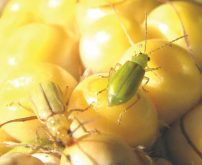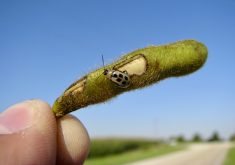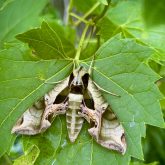Western Bean Cutworm is now the most economically significant pest in corn, but it’s quickly becoming a challenge in other nearby crops, especially dry beans.
Why it matters: Scouting for Western Bean Cutworm (WBC) is much more challenging in dry beans than corn, so knowing the status of nearby corn fields and increasing moth trap numbers in bean fields are important.
WBC have little impact on yield in Ontario – the problem is that their feeding on cobs lets in moulds that increase mycotoxin levels in corn, making the crop potentially less saleable or downgraded in quality. In dry beans, however, the cutworms burrow into the pods, said Tracey Baute, OMAFRA’s field crop entomologist.
Read Also

The forced Japanese-Canadian farmers of the Second World War
Manitoba’s sugar beet farms drew on displaced Japanese-Canadians from B.C. during the Second World War
Dry bean fields are most at risk once the corn is past full tassel stage.
“If adjacent corn fields reach threshold, it’s likely the dry bean field will too,” said Baute at FarmSMART in Guelph. She called scouting for WBC in dry beans “very difficult” because they lay their eggs under the leaves in beans, and deep within the canopy, whereas they lay on the upper leaves of corn and can often be seen easily.
Look for small holes in pods. Scout 10 plants in 10 areas of a dry bean field during early pod stages. Pod feeding usually happens 10 to 20 days after peak flight.
Researchers are still learning about when to spray WBC in dry beans, and as a result there aren’t yet good integrated pest management recommendations.
Michigan researchers say if there are more than 150 moths in a trap, they will be highly likely be a need for dry beans to be sprayed, said Baute.
The good news is that control is easier in dry beans than in corn.
Meghan Moran, OMAFRA’s edible bean specialist said that cranberry beans appeared to be the most affected, because when tiny holes are made in the bean pods, the oxygen level changes and the cranberry beans become discolored. That means higher “pick” levels, meaning amounts that have to be sorted off and are discounted.
Cranberry bean growers may need to be more vigilant than other edible beans growers, she said.
Researchers and farmers, however, continue to learn how to manage WBC in corn, as the insect is found across more of Ontario’s corn growing area.
Here is some of the latest thinking and some reminders about managing WBC in corn:
- Moths fly at night. Michigan State University found the bulk of flights occur between 1 a.m. and 3 a.m.
- The moths have easily identifiable markings: white margins along the forewings, with a solid circle or and then a boomerang or comma shape further back. However, once they’ve been stuck in a pheromone trap for a few days, they tend to have rubbed the scales off their wings, and there also the markings. Don’t think they aren’t WBC moths.
- Scout 10 plants in ideal growth stage in 10 areas of field, so 100 plants each time, looking for egg masses. It’s ideal when you can get the sun between you and the leaf in order to illuminate the egg masses.
- The threshold for spraying for WBC has continued to evolve. The now accepted threshold, said Baute is a cumulative five per cent threshold, meaning when five per cent of the plant in a two or three-week period have had egg masses and/or small larvae. If a hybrid is susceptible to fusarium, the an even lower threshold is likely needed.
- Make sure to rotate modes of action of insecticides in order to decrease the likelihood of the Western Bean Cutworm developing resistance. There are four insecticides used for WBC control. Two, Matador or Silencer (pyrethroids), and Voliam Xpress (pyrethroid and diamide) are both being re-examined by Health Canada. The other two are Coragen (diamide) and Delegate (spinosyns).
- Remember that the Cry1F Bt traits have no effect on WBC. Only corn with the Vipterra traits have effective control of WBC.















